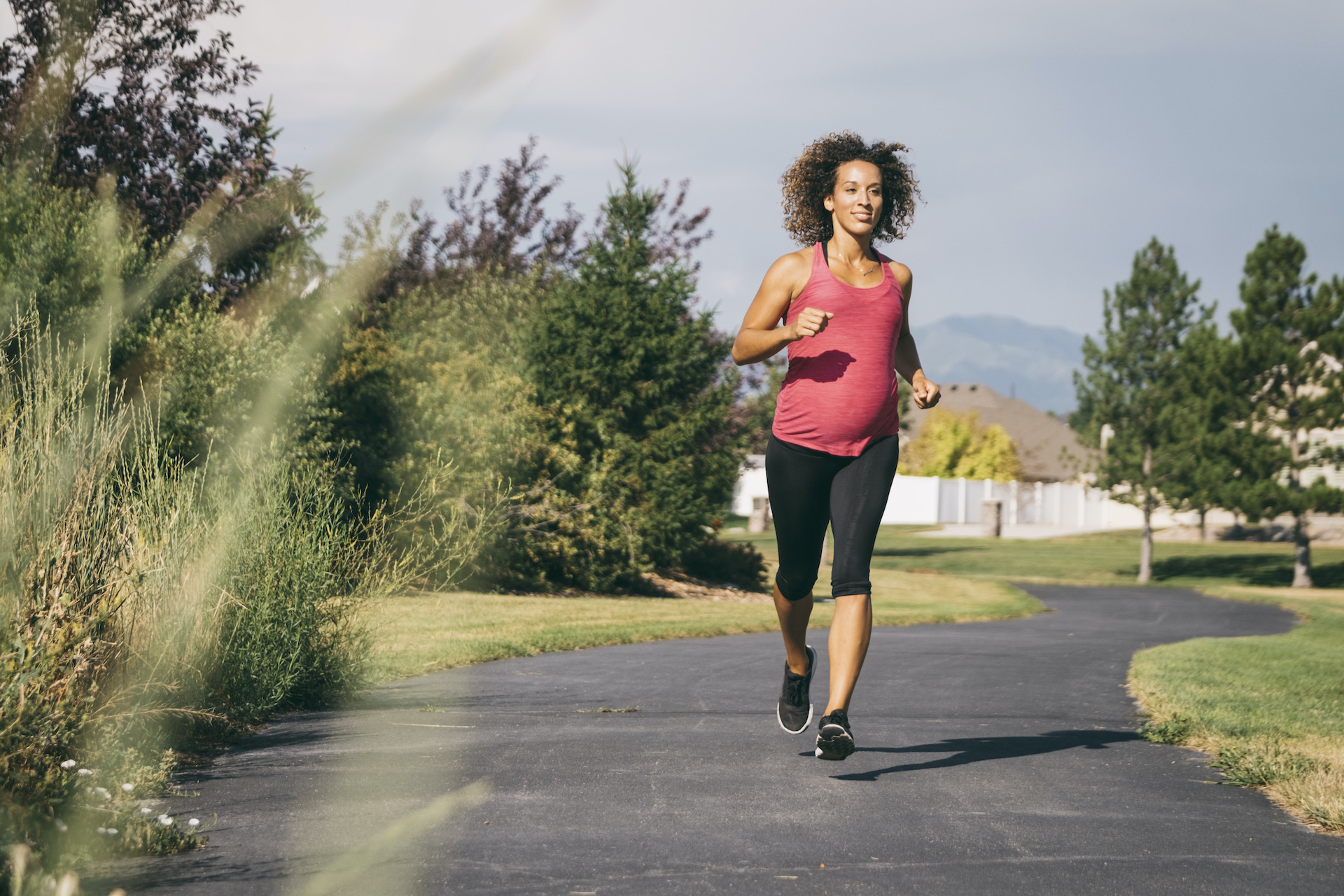
With so much information swirling around about exercising during pregnancy, it's easy to feel overwhelmed by it all.
The guidance around postnatal exercise is fairly clear cut; most women should wait until their six-week postnatal check before returning to strenuous exercise, although gentle workouts may be possible before this for those who had a ‘straightforward’ birth (i.e. not a C-section of significant tearing).
However, many expectant mums find the advice around which pregnancy exercises they can and can’t do a little more confusing. Should you carry on exercising as you always have – or stop completely? Is it safe to run when pregnant? And is it true you can't lie on your back – in an online pregnancy yoga class, for example – after the 16-week mark?
Official guidelines from the UK’s Chief Medical Officer confirm that exercise is beneficial during pregnancy and should be encouraged. They recommend aiming for 150 minutes of moderate intensity activity a week, along with two muscle-strengthening activities.
"Moving your body during pregnancy is incredibly beneficial for both your body and mind," confirms Ash Ormond, a physiotherapist with a special interest in women's health.
She does note, however, that exercise may need to be adapted during pregnancy in order to keep you and your baby safe. "Always get your doctor's approval, stay hydrated and listen to your body,” she advises.
“With some simple precautions, you can safely continue strength, stretching and cardiovascular exercise during this special time."
Below, we separate fact from fiction so you can keep exercising safely and confidently throughout your pregnancy.
11 exercise myths around pregnancy
Myth 1: You should carry on exercising as you always have
Whilst the official guidelines give the green light to anyone who wants to continue exercising during their pregnancy, there are key modifications you’ll need to make in order to keep you and your baby safe and healthy.
Most notably, the guidelines specify that any activity should be performed to a moderate intensity. A key indicator of this is the ‘talk test’ – that is, you should still be able to hold a conversation whilst working out.
It can be helpful to think in terms of percentages, says Shakira Akabusi, a pre and postnatal fitness expert and the founder of Strong Like Mum. “For cardiovascular exercise, I advise working to 70% of your maximum effort, dropping down to 50% in your third trimester,” she says.
This will obviously differ not only from person to person, but also from week to week as your pregnancy progresses, and even day to day based on how you are feeling – so it’s important to listen to your body and only do what you feel capable of and comfortable with.
The guidelines also highlight activities that are a no-no during pregnancy. These include anything that risks ‘bumping the bump’, such as martial arts or ball sports, or where there is a high risk of falling, such as horse-riding and skiing. Scuba diving and anything performed at high altitude is also on the list.
Certain exercises, such as core work and any move that requires you to lie flat on your back, will also need to be modified – as we explain in more detail below.
Myth 2: Exercising in pregnancy leaves you more tired
Tiredness is a common complaint in pregnancy, and you might think that exercising would only add to this. However, the opposite is actually true. “The chemical process that happens when we exercise actually creates more energy in the body,” says Shakira.
If you do find that you are significantly more tired after exercise, this could be a sign of overexertion, she adds – so, once again, it’s important to maintain a moderate intensity.
She also highlights the importance of staying hydrated and refuelling after exercise to help maintain energy levels, as well as giving the body ample opportunity to recover.
“Rest is equally important as exercise, particularly in the third trimester and the run up to birth,” she says. “So in those last few weeks of the third trimester, maybe your 50% is just going for a ten minute walk.”
Myth 3: You can't do exercises on your back after 16 weeks
Government guidelines state that you should avoid lying on your back for more than a few minutes, particularly after 16 weeks.
This is because the growing weight of your baby puts pressure on the vena cava, a large vein that carries blood to your heart. This can lead to supine hypotension syndrome, symptoms of which can include feeling sick, dizziness, headaches, lightheadedness, breathlessness and a general feeling of discomfort.
However, in line with the guidelines, it’s fine to perform some exercises lying on your back for a short period of time provided it feels comfortable and you don’t experience any of these symptoms.
Some women may find that propping themselves up can help them continue to exercise on their back. For example, Hollie suggests using a pregnancy wedge, some pillows or a Pilates ball behind the shoulders.
Ultimately it’s about finding what feels right for you within the limits of the guidelines. "Lots of people are totally comfortable on their backs way beyond 16 weeks, and if it's not causing any symptoms, the person should be fine to be there for a short time," Grace says.
Mum-of-four Shakira adds: “In my first two pregnancies, I felt really comfortable on my back right up until the end of my third trimester. But with my twin pregnancy, at the start of the second trimester I already couldn’t lie on my back.”
Myth 4: You can’t run in pregnancy
If you were a runner prior to getting pregnant, it is safe to continue doing so as long as it still feels comfortable.
However, as a high-impact activity, symptoms such as hip and back pain and incontinence can pose a challenge for runners during pregnancy due to the extra weight of your growing bump.
"As soon as symptoms start, you need to reconsider how you are exercising and adapt," Grace says. This may mean reducing the length of time you run for, as well as taking the intensity down to a light jog or even a brisk walk.
She adds that such modifications may be beneficial towards the end of your pregnancy even if you are not experiencing symptoms, due to the increased pressure on your pelvis and pelvic floor.

Myth 5: Cycling is too risky after the first trimester
Cycling can be a great way to contribute towards hitting the recommended 150 minutes of moderate intensity weekly activity throughout your pregnancy. Just be sure to keep your level of exertion at a level that passes the talk test.
However, given the increased risk of falling, it’s probably best to forgo any trails or busy city streets in favour of a stationary exercise bike instead.
Ash explains: "While high speeds or tricky terrain should be avoided, stationary cycling is gentle on your joints and an effective way to maintain cardio fitness.
“Ride at an easy pace and intensity and make sure the bike is properly adjusted. Avoid leaning too far forward, listen to your body and stop if you feel discomfort."
Make sure you've got a bottle of water with you to stay hydrated. You could also place a fan in front of your exercise bike to avoid overheating.
Myth 6: You shouldn't lift weights when pregnant
Weight training in pregnancy can be incredibly beneficial – and not just only because it prepares you for all the lifting you’ll be doing once the baby arrives.
“Anyone who’s already a mother will know that you are constantly lifting weights, so weight training is really encouraged in pregnancy,” says Shakira.
The advice differs depending on whether you lifted prior to falling pregnant or not
New to weights
If you didn’t lift weights pre-pregnancy, it’s best to build up slowly. Shakira recommends starting with forms of strength training that don’t involve weights, such as resistance band exercises, before progressing to light free weights such as dumbbells.
Experienced in lifting weights
If you did train with weights before falling pregnant, it’s advisable to opt for lighter weights, especially as your pregnancy progresses. “I always advise my clients not to lift more than 50-70% of their maximum weight throughout their second two trimesters,” says Shakira.
Ditching the quick repetitions is also advised. “During pregnancy, I would always advise clients to lift slowly and controlled as opposed to working really quickly.”
Reducing the weight and speed of your workouts will help to avoid overexertion and injury, which pregnant people can be more prone to due to an increase in the hormone relaxin.
“The role of this hormone is to loosen the joints in and around the pelvis so that the pelvis can move and the baby can move down the birth canal,” explains Shakira. “But the effects aren’t just isolated to the pelvis – they happen across all the joints in the body, causing them to be less stable and putting us more at risk of injury.”

You should also avoid lifting weights overhead towards the end of the second trimester and in the third. This is because of the way our posture changes as pregnancy progresses.
“As our bump grows the pelvis shifts out of alignment, which naturally puts a lot more pressure onto the pelvic floor, which is supporting not only the baby, but also amniotic fluid and placenta,” explains Shakira.
“Once the posture changes and that weight bears more onto the pelvic floor muscles, that’s when I would advise to lift weights no further than shoulder height, or to work on something below the shoulders, such as bicep curls or weighted lunges.”
Myth 7: Swimming pool workouts aren't safe in pregnancy
Swimming is generally viewed as a fantastic way to workout during pregnancy, with many valuing the feeling of virtual weightlessness it gives expectant mums.
However, previous scare stories have given rise to an (unfounded) fear that swimming in chlorinated water can be harmful to unborn babies, potentially leading to birth defects.
This notion was debunked by a 2010 study of over 70,000 pregnant women. It concluded that swimming in pool water was not associated with adverse outcomes. In fact, the opposite was true, with the study concluding that women who swam in early and mid-pregnancy were less likely to give birth to babies with malformations than those who did not exercise. They also had a slightly reduced chance of preterm delivery.
Ash tells us: "Swimming and water workouts are fantastic options throughout pregnancy as the water supports your weight. The buoyancy of the water makes swimming very joint-friendly, allowing you to maintain strength and cardio fitness. Some great moves are walking laps, gentle water aerobics and gentle lap swimming."
You may, however, want to give hot tubs and jacuzzis a swerve during pregnancy, due to an increased risk of overheating, dehydration and fainting.
Myth 8: You can’t work your abdominals in pregnancy
Contrary to common belief, you can still continue to work your abs during pregnancy. However, it’s important to modify any abdominal work in a way that manages the pressure it creates in your core.
“During pregnancy, your rectus abdominus muscles (AKA your six pack muscles) move away from each other to make space for your bump,” explains Hollie Grant, a pre and postnatal Pilates expert and the founder of The Bump Plan. “This causes the tissue between those two muscles, the linea alba, to stretch and thin.”
To prevent damage to this thinned and stretched tissue, she says it’s important to avoid aggressive ‘doming’ whilst performing core exercises. So what are the signs to look for? “The tummy goes pointy like a Toblerone as pressure is pushed out through the gap between your rectus abdominis muscles.”.
Whilst soft doming is OK, Hollie says that hard doming should be avoided. “If it’s aggressive, very hard, and uncomfortable, it’s time to modify!” You can manage doming by making the exercises a little less intensive, or avoiding them completely if you find you can’t do them without doming occurring.

Of course, as pregnancy progresses most people will get to a stage where abdominal work is logistically impossible or too uncomfortable, or can’t be done without hard doming.
For this reason, Shakira argues that it can be helpful to focus on exercising the core as a whole, rather than the abdominals exclusively, to aid a healthy pregnancy and efficient postpartum recovery.
“I would always question not just what can you do, but what’s the most beneficial? And crunches and sit-ups are just not the most beneficial thing.”
She encourages exercises that target the deeper abdominal muscles, including the transverse abdominis, and the pelvic floor. “This will help us create a strong core that will support your growing body, the spine and your posture, without placing too much pressure on that weakened front tissue.”
Static contraction exercises such as modified plank (performed on the knees), bird dog (where you extend opposite arms and legs from a hands and knees position) and bridges (where you lie on your back with your knees bent and raise your hips) are all great for targeting these muscles.
Myth 9: Pilates should be avoided after the first trimester
As a low-impact and low-to-moderate intensity activity, Pilates is a great way to continue moving throughout pregnancy. However, some Pilates moves will obviously become more logistically challenging – or outright impossible – as your bump grows, most notably in the second and third trimesters.
These include moves that involve:
These moves require special attention and modifications, as outlined below. As such, it’s best to attend a class (whether in person or online) that’s specifically designed for pregnancy, with a qualified prenatal Pilates instructor.
“That way, they can really ensure that any exercise you do is safe and will actually benefit you, whether that’s by making pregnancy more comfortable or making labour smoother,” says Hollie.
Pilates exercises performed on your front
For obvious reasons, anything that involves lying on your front should be avoided once it is no longer an option for you and your bump.
Pilates exercises that target the core
Moves that work the core such as roll-ups, ab curls and crunches are fine to continue with as long as your bump allows, but will typically require some modification.
“People might think that you can’t do crunches in pregnancy, but that’s outdated advice,” shares Hollie. “We now know that you should continue to do core work in pregnancy, and that’s one reason Pilates is so great for you.”
However, it is vital that you avoid aggressive doming, as outlined in point eight above.

Pilates exercises performed on your back
NHS advice states to avoid lying on your back for more than a few minutes when pregnant. However, you can continue to do Pilates moves that require you to lie on your back, says Hollie, so long as you limit how long you do them for and mix them up with other moves.
“For example, you could do one exercise lying on your back for a minute or two, but then change position and do something lying on your side, then something in standing,” she suggests.
As with all exercise, the key is to listen to your body, stop if anything feels uncomfortable or wrong, and seek advice if you’re unsure about how to continue.
Myth 10: Exercise will trigger preterm labour
Preterm labour is defined as labour that occurs before the 37th week of pregnancy, the point commonly referred to as ‘full-term’.
"While overexertion is not advised, regular exercise has not been linked to preterm labour," Ash says.
Indeed, research has confirmed that women who exercise moderately during pregnancy are no more likely to experience preterm labour than those who do not exercise.
The study of 2,059 healthy pregnant women also found that exercise could increase the chance of a vaginal delivery, and reduce the risk of developing conditions such as diabetes and high blood pressure during pregnancy.
And more recent research has suggested that exercise can actually reduce the chances of preterm birth.
Myth 11: Kegel exercises alone will maintain good pelvic floor health
You’ll hear a lot about the importance of pelvic floor exercises – also known as kegel exercises – during pregnancy. These are designed to help strengthen the pelvic floor muscles, which support the bladder, bowel and uterus, and are placed under increased pressure during pregnancy.
However, kegel exercises alone are just one piece of the pelvic health puzzle, and should ideally be practised in conjunction with other exercises that also help the surrounding muscles that support the pelvis to stay strong and flexible.
“We don’t just need our pelvic floor to function when we’re sitting or lying down,” says Shakira. “We also want it to function when we’re doing everyday movements, so we want to replicate that with our exercise.” Exercises such as squats, lunges and bridges are all great for achieving this.
Meanwhile, Hollie points to single-leg exercises as another great way to strengthen your pelvic floor. Examples include single-leg deadlifts and scooter, where you stand on one leg and the other leg stretches out behind you, perhaps tapping the floor.
Efficient breathing is also key in helping the pelvic floor to relax and release effectively. “Breathwork is a really helpful way to make sure that your pelvic floor is flexible, and not just strong,” Hollie says.
“When you breathe efficiently using the diaphragm (the inhaling muscle), the pelvic floor lengthens and stretches as you breathe in to manage the increased pressure that’s created in your core. Then when you breathe out, the air is blown out and the diaphragm relaxes, and your pelvic floor goes back to normal.”







